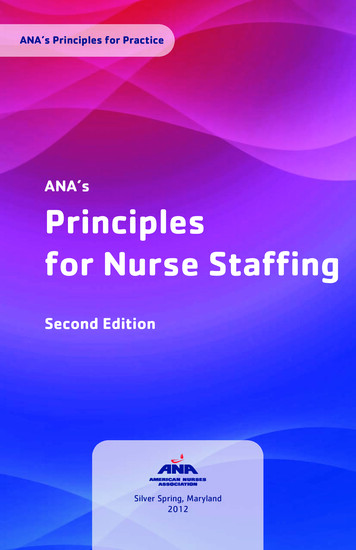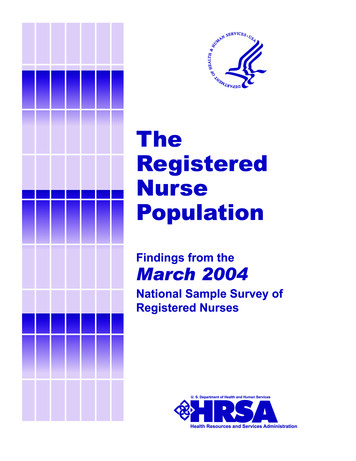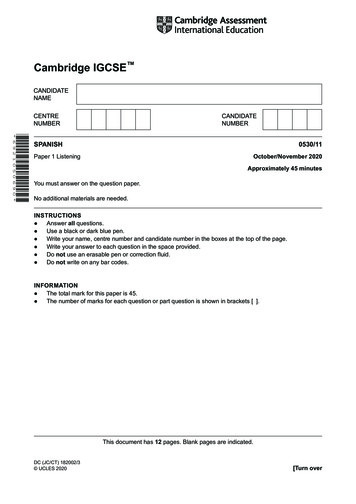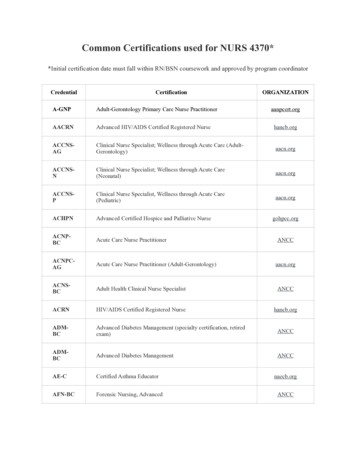
Transcription
ANA’s Principles for PracticeANA’sPrinciplesfor Nurse StaffingSecond EditionSilver Spring, Maryland2012
SummaryThe 2012 ANA Principles for Nurse Staffing identify the majorelements needed to achieve optimal staffing, which enhances thedelivery of safe, quality care. These principles apply to all types ofnurse staffing at every practice level and in any healthcare orpractice setting. They are grounded in the substantive andgrowing body of evidence that demonstrates the link betweenadequate nurse staffing and better patient outcomes. Focused onaddressing the complexities of nurse staffing decisions, theprinciples and supporting material in this publication will guidenurses and other decision-makers in identifying and developingthe processes and policies needed to improve nurse staffing.American Nurses Association8515 Georgia Avenue, Suite 400Silver Spring, MD hed by:www.Nursesbooks.org 2012 American Nurses Association. All rights reserved. No part of this book may be reproduced orutilized in any form or any means, electronic or mechanical, including photocopying and recording, orby any information storage and retrieval system, without permission in writing from the publisher.ISBN-13: 978-1-55810-443-2Published June 2012
ANA’s Principles for Nurse Staffing, 2nd Edition 1Contents2Overview of Nurse Staffing5Principles for Nurse StaffingDefinition of Appropriate Nurse StaffingCore Components of Nurse StaffingPrinciples Related to the Healthcare ConsumerPrinciples Related to Registered Nurses andOther StaffPrinciples Related to Organization andWorkplace CulturePrinciples Related to the Practice EnvironmentPrinciples Related to Staffing EvaluationConclusion12 Bibliography22 Contributors 2012 American Nurses Association. All rights reserved. No part of this book may be reproduced orutilized in any form or any means, electronic or mechanical, including photocopying and recording, orby any information storage and retrieval system, without permission in writing from the publisher.
Overview ofNurse StaffingANA’s Principles for Nurse Staffing, 2nd Edition Overview of Nurse Staffing 2
ANA’s Principles for Nurse Staffing, 2nd Edition Overview of Nurse Staffing 3Overview of Nurse StaffingAppropriate nurse staffing is critical to the delivery of safe, quality care thatimpacts patient care outcomes. Nursing is an essential component ofcomprehensive healthcare. Staffing impacts the ability of a nurse to deliver safe,quality care at every practice level and in all practice settings. Because thedelivery of nursing care is a multifaceted process, the determination ofappropriate nurse staffing is complex. The solution is not as simple as increasingthe number of nurses beyond what is minimally necessary.While the issue of staffing is complex, it is not unsolvable. It challenges theprofession to create dynamic solutions that are adaptable to the ever-evolvingnature of health care. Many types of staffing solutions have been developed,which are in turn tested and evaluated through quality measurement andresearch. In turn, this evidence drives the nursing profession to supportprinciples that are needed to guide registered nurses and others in determiningtheir individual solutions to this enigmatic issue.Using this evidence, the American Nurses Association (ANA) develops anddisseminates principles that served as the guidelines for determining registerednurse staffing solutions. Since the initial publication of Principles for NurseStaffing (ANA, 1999), the evidence supporting the link between adequate nursestaffing and better patient outcomes has grown. ANA’s advocacy for nursestaffing includes developing data collection methods, principles, and policysolutions for nurse staffing. Among these are the National Database for NursingQuality Indicators (NDNQI ), ongoing lobbying at the federal and state levels,and facilitation of ANA expert panels and research synthesis.Another culmination of the growth of the body of evidence and ANA’s advocacyis this document, Principles for Nurse Staffing, Second Edition, After conducting athorough review of the available literature, those original staffing principles wereassessed systematically and scientifically for relevance, applicability, and gaps.The original edition had been supported by twelve publications (which aredenoted in this document by asterisks in the Bibliography). The supportdocumentation for this revision was expanded to include the increasingpublished literature currently available on the topic of nurse staffing. Theserevised staffing principles set forth in this edition apply to any level or setting ofnursing, and form the basis of the activity or policy of specialty nursingassociations around staffing. 2012 American Nurses Association. All rights reserved. No part of this book may be reproduced orutilized in any form or any means, electronic or mechanical, including photocopying and recording, orby any information storage and retrieval system, without permission in writing from the publisher.
ANA’s Principles for Nurse Staffing, 2nd Edition Overview of Nurse Staffing 4The ANA Principles for Nurse Staffing as delineated in this document reflectthe intricate nature of how decisions are made toward ensuring appropriatenurse staffing. Supporting these principles are foundational statementsregarding key aspects of nurse staffing that are enduring and core beliefs ofANA’s approach, and are described on page 6.An overarching characteristic of these principles are the different dynamicsof given healthcare settings and situations and what elements of thesedynamics must be considered when developing staffing plans. Accordingly,the ANA Principles for Nurse Staffing are organized into five sets accordingto these topics: The characteristics and considerations of the healthcare consumer The characteristics and considerations of the registered nurses and otherinterprofessional team members and staff The context of the entire organization in which the nursing servicesare delivered The overall practice environment that influences delivery of care The evaluation of staffing plans1A healthcare consumer is “the person, client, family, group, community, or populationwho is the focus of attention and to whom the registered nurse is providing services assanctioned by the state regulatory bodies.” (ANA, 2012; pg. 65) 2012 American Nurses Association. All rights reserved. No part of this book may be reproduced orutilized in any form or any means, electronic or mechanical, including photocopying and recording, orby any information storage and retrieval system, without permission in writing from the publisher.
Principles forNurse StaffingDefinition of Appropriate Nurse StaffingCore Components of Nurse StaffingPrinciples Related to the Healthcare ConsumerPrinciples Related to Registered Nurses and Other StaffPrinciples Related to Organization and Workplace CulturePrinciples Related to the Practice EnvironmentPrinciples Related to Staffing EvaluationANA’s Principles for Nursing Documentation The Uses of Nursing Documentation 5
ANA’s Principles for Nurse Staffing, 2nd Edition Principles for Nurse Staffing 6Principles for Nurse StaffingDefinition of Appropriate Nurse StaffingAppropriate nurse staffing is a match of registered nurse expertise with the needsof the recipient of nursing care services in the context of the practice settingand situation. The provision of appropriate nurse staffing is necessary to reachsafe, quality outcomes; it is achieved by dynamic, multifaceted decisionmaking processes that must take into account a wide range of variables.Core Components of Nurse Staffing Appropriate nurse staffing is critical to the delivery of quality, cost-effectivehealth care. All settings should have well-developed staffing guidelines with measurablenurse sensitive outcomes specific to that setting and healthcare consumerpopulation that are used as evidence to guide daily staffing. Registered nurses are full partners working with other healthcareprofessionals in collaborative, interdisciplinary partnerships. Registered nurses, including direct care nurses, must have a substantive andactive role in staffing decisions to assure the necessary time with patients tomeet care needs and overall nursing responsibilities. Staffing needs must be determined based on an analysis of healthcareconsumer status (e.g., degree of stability, intensity, and acuity), and theenvironment in which the care is provided. Other considerations to beincluded are: professional characteristics, skill set, and mix of the staff, andprevious staffing patterns that have been shown to improve outcomes. Appropriate nurse staffing should be based on allocating the appropriatenumber of competent practitioners to a care situation; pursuing quality ofcare indices; meeting consumer-centered and organizational outcomes;meeting federal and state laws and regulations; and attending to a safe,quality work environment. Cost effectiveness is an important consideration in delivery of safe, quality care. Reimbursement structure should not influence nurse staffing patterns or thelevel of care provided. 2012 American Nurses Association. All rights reserved. No part of this book may be reproduced orutilized in any form or any means, electronic or mechanical, including photocopying and recording, orby any information storage and retrieval system, without permission in writing from the publisher.
ANA’s Principles for Nurse Staffing, 2nd Edition Principles for Nurse Staffing 7Principles Related to the Healthcare ConsumerStaffing decisions should be based on the number and needs of the individualhealthcare consumer, families and population served. These include: Age and functional abilityCommunication skillsCultural and linguistic diversitiesSeverity, intensity, acuity, complexity, and stability of conditionExistence and severity of multi-morbid conditionsScheduled procedure(s)Ability to meet heathcare requisitesAvailability of social supportsTransitional care, within or beyond the healthcare settingContinuity of careComplexity of care needsEnvironmental turbulence (i.e., rapid admissions, turnovers, and/or discharges)Other specific needs identified by the healthcare consumer, the family andthe registered nurseIn any approach used to determine staffing consideration must be given to theelements affecting care at the individual setting level. No single method, model orassessment tool (e.g., nursing hours per patient day [NHPPD], nursing intensityweights, strict nurse-to-patient ratios) has provided sufficient evidence to beconsidered optimal in all settings and all situations. Each setting should havestaffing guidelines based on safety indicators and outcomes specific to that area.The following elements are to be considered when making the determination: Governance within the setting (i.e., shared governance)Involvement in quality measurement activitiesQuality of work environment of nursesDevelopment of comprehensive plans of carePractice environmentArchitectural geography of unit and institution 2012 American Nurses Association. All rights reserved. No part of this book may be reproduced orutilized in any form or any means, electronic or mechanical, including photocopying and recording, orby any information storage and retrieval system, without permission in writing from the publisher.
ANA’s Principles for Nurse Staffing, 2nd Edition Principles for Nurse Staffing 8 Evaluation of practice outcomes that include both quality and safety Available technology Evolving evidencePrinciples Related to Registered Nurses and Other StaffThe specific needs of the population served should determine the appropriateclinical competencies required of the registered nurse practicing in that area.The organization must specify the appropriate credentials and qualifications ofregistered nurse staff, while ensuring registered nurses are permitted to practiceto the full extent of their education, training, and licensure.The following nurse characteristics should be taken into account whendetermining staffing: LicensureExperience with the population being servedLevel of experience (i.e., novice to expert)Competency with technology and clinical interventionsProfessional certificationEducational preparationLanguage capabilitiesOrganizational experienceStaffing plans should accommodate for experienced registered nurses who canoffer clinical support to other staff. Adjustments in staffing should beconsidered to incorporate mentoring and skill development needs of nurses,including novice nurses.Factors such as nurse satisfaction, burnout, turnover, retention, preceptingstudents or new staff, acting as a mentor, care coordination, skill withtechnology, use of agency or contractual staff, competency requirements, andstaff development should be monitored regularly to ensure that staffingoutcomes are measured and adjusted. Nursing students and precepted studentsare not staff and cannot be treated as such. 2012 American Nurses Association. All rights reserved. No part of this book may be reproduced orutilized in any form or any means, electronic or mechanical, including photocopying and recording, orby any information storage and retrieval system, without permission in writing from the publisher.
ANA’s Principles for Nurse Staffing, 2nd Edition Principles for Nurse Staffing 9Registered nurses must have the decision-making authority to alter staffing toaccommodate changing and anticipated healthcare consumer needs, registerednurse competency and skill levels, in order to assure appropriate staffing inrapidly changing situations.Principles Related to Organization and Workplace CultureOrganizations must create a work environment that values registered nursesand other employees as strategic assets and fills budgeted positions in atimely manner.Policies should support the ability of registered nurses to practice to the fullextent of their education, documented competencies, and scope of practice.To maximize safe patient care and quality outcomes, organizations shouldrecognize that in addition to appropriate registered nurse staffing, they mustprovide interprofessional support and ancillary services. These include at aminimum: Effective and efficient support services (e.g., transport, clerical,housekeeping, and laboratory) Timely coordination, supervision, and delegation as needed to maximizesafety Access to timely, accurate, relevant information provided by communicationtechnology that links clinical, administrative, and outcome data Sufficient orientation and preparation, including nurse preceptors and nurseexperts to ensure registered nurse competency Preparation and ongoing training for competency in technology or othertools Sufficient time for patient documentation Necessary time to collaborate with and supervise other staff Necessary time to accommodate increased documentation demands createdby integration of technology, electronic records, surveillance systems, andregulatory requirements Support in ethical decision-making Resources and pathways for care coordination and healthcareconsumer/client and/or family education 2012 American Nurses Association. All rights reserved. No part of this book may be reproduced orutilized in any form or any means, electronic or mechanical, including photocopying and recording, orby any information storage and retrieval system, without permission in writing from the publisher.
ANA’s Principles for Nurse Staffing, 2nd Edition Principles for Nurse Staffing 10 Adequate time for coordination and supervision of nursing assistivepersonnel by registered nurses Processes to facilitate transitions during work redesign, mergers, and othermajor changes in work life Supporting the registered nurse’s professional responsibility to maintaincontinuing education and engagement in lifelong learningSuccessful staffing requires organizational and administrative support from alllevels. In addition, registered nurses, including direct care nurses, must beengaged and participatory in decision-making.Nurse administrators are responsible for facilitating the provision ofappropriate nurse staffing and to collaborate with others in the organization toassure the best use of resources.Principles Related to the Practice EnvironmentStaffing is a structure and process that affects the safety of patients, as well asnurses themselves, and others in the environment. Institutions employing aculture of safety must recognize appropriate nurse staffing as integral toachieving goals for patient safety and quality.Registered nurses have a professional obligation to report unsafe conditions orinappropriate staffing that adversely impacts safe, quality care, and the right todo so without reprisal.Registered nurses should be provided a professional nursing practice environmentin which they have control over nursing practice and autonomy in their workplace.Appropriate preparation, resources and information should be provided for thoseinvolved at all levels of decision-making. Opportunities must be provided forindividuals to be involved in decision-making related to nursing practice.Routine mandatory overtime is an unacceptable solution to achieve appropriatenurse staffing. Policies on length of shifts; management of meal and restperiods; and overtime should be in place to ensure the health and stamina ofnurses and prevent fatigue-related errors.Principles Related to Staffing EvaluationOrganizations must have registered nurse staffing plans that demonstrate alogical method for determining staffing levels and skill mix, and are conduciveto change based on analysis of evaluation data. 2012 American Nurses Association. All rights reserved. No part of this book may be reproduced orutilized in any form or any means, electronic or mechanical, including photocopying and recording, orby any information storage and retrieval system, without permission in writing from the publisher.
ANA’s Principles for Nurse Staffing, 2nd Edition Principles for Nurse Staffing 11Organizations should evaluate staffing plans based on factors including,but not limited to: Outcomes, especially as measured by nurse-sensitive indicatorsTime needed for direct and indirect patient careWork-related staff illness and injury ratesTurnover/vacancy ratesOvertime ratesRate of use of supplemental staffingFlexibility of human resource policies and benefit packagesEvidence of compliance with applicable federal, state, and local regulationsLevels of healthcare consumer satisfaction and nurse satisfaction.Staffing plans must be conducive to adjustment to reflect changes in evidenceand outcomes, care scenarios, and the needs of the population served, all ofwhich can vary from hour to hour, day to day, and shift to shift.Evaluation of any staffing system should include factors associated with theenvironment with an understanding of how that particular environment affectshealthcare consumer safety and outcomes.When evaluating cost of nursing staffing, the organization should take intoaccount the cost of adverse outcomes when staffing is inappropriate.ConclusionDespite the efforts at all levels of the nursing profession, heightened and moreimmediate attention is needed to assure the provision of safe, quality nursingcare. Appropriate nurse staffing must be considered an asset to ever-evolvinghealth care systems, rather than simply a cost factor. Evidence demonstrates thatnursing care has a direct impact on the overall quality of services received, andthat when registered nurse staffing is adequate, adverse events decline and overalloutcomes improve. It is imperative that the healthcare paradigm shift towardsbetter health at lower costs includes an increased emphasis on the importance ofappropriate nurse staffing. Nurses make a tremendous contribution to qualitycare: the value of registered nurse staffing cannot be underestimated. 2012 American Nurses Association. All rights reserved. No part of this book may be reproduced orutilized in any form or any means, electronic or mechanical, including photocopying and recording, orby any information storage and retrieval system, without permission in writing from the publisher.
BibliographyANA’s Principles for Nurse Staffing, 2nd Edition Bibliography 12
ANA’s Principles for Nurse Staffing, 2nd Edition Bibliography 13(* included in original 1999 Principles for Nurse Staffing document)Aaronson, L. S., & Sochalski, J. (1986). Re: Institutional sources of articlespublished in 13 nursing journals, 1978–1982. Nursing Research, 35(1), 59–60.Aiken, L. H. (2010a). The California nurse staffing mandate: Implications forother states. LDI Issue Brief, 15(4), 1–4.Aiken, L. H. (2010b). The jury’s in: Staffing laws work. Interview by CarolPotera. American Journal of Nursing, 110(7), 15.Aiken, L. H., Buchan, J., Sochalski, J., Nichols, B., & Powell, M. (2004).Trends in international nurse migration. Health Affairs, 23(3), 69–77.Aiken, L. H., Clarke, S. P., Sloane, D. M., & Sochalski, J. (2001). Cause forconcern: Nurses’ reports of hospital care in five countries. LDI Issue Brief,6(8), 1–4.Aiken, L. H., Clarke, S. P., Sloane, D. M., Sochalski, J., & Silber, J. H. (2002).Hospital nurse staffing and patient mortality, nurse burnout, and jobdissatisfaction. Journal of the American Medical Association, 16, 1987–1993.Aiken, L. H., Clarke, S. P., Sloane, D. M., Sochalski, J. A., Busse, R., Clarke,H., . Shamian, J. (2001). Nurses’ reports on hospital care in five countries.Health Affairs, 20(3), 43–53.Aiken, L. H., Patrician, P.A. (2000). Measuring organizational traits of hospitals:The revised Nursing Work Index. Nursing Research, 49,(3), 146–153.Aiken, L. H., Sloane, D. M., Cimiotti, J. P., Clarke, S. P., Flynn, L., Seago, J.A., . Smith, H. L. (2010). Implications of the California nurse staffingmandate for other states. Health Services Research, 45(4), 904–921.Aiken, L. H., Sloane, D. M., & Sochalski, J. (1998). Hospital organisation andoutcomes. Quality Health Care, 7(4), 222–226.*Aiken, L. H., Smith, H. L. & Lake, E. T. (1994). Lower Medicare mortalityamong a set of hospitals known for good nursing care. Medical Care. 32(8),771–787.Aiken, L. H., Sochalski, J., & Anderson, G. F. (1996). Downsizing the hospitalnursing workforce. Health Affairs 15(4), 88–92.Aiken, L. H., Sochalski, J., & Lake, E. T. (1997). Studying outcomes oforganizational change in health services. Medical Care, 35(11 Suppl), NS6–18.*American Nurses Association (1997). Implementing Nursing’s Report Card: Astudy of RN Staffing, length of stay and patient outcomes. Washington, DC:American Nurses Publishing.American Nurses Association (1999). Principles for nurse staffing. Washington,DC: Author. 2012 American Nurses Association. All rights reserved. No part of this book may be reproduced orutilized in any form or any means, electronic or mechanical, including photocopying and recording, orby any information storage and retrieval system, without permission in writing from the publisher.
ANA’s Principles for Nurse Staffing, 2nd Edition Bibliography 14American Nurses Association (2010). Nursing: Scope and standards of practice,2nd Ed. Silver Spring, MD: Nursesbooks.org.Bae, S. H., Mark, B., & Fried, B. (2010). Impact of nursing unit turnover onpatient outcomes in hospitals. Journal of Nursing Scholarship, 42(1), 40–49.Baernholdt, M., & Mark, B. A. (2009). The nurse work environment, jobsatisfaction and turnover rates in rural and urban nursing units. Journal ofNursing Management 17(8), 994–1001.Birmingham, S. E. (2010). Evidence-based staffing: The next step. NurseLeader, (June), 24–35.Black, L., Spetz, J., & Harrington, C. (2008). Nurses working outside ofnursing: Societal trend or workplace crisis? Policy, Politics, & Nursing Practice,9(3), 143–157.*Bridges, W. (1991). Managing transitions: Making the most of change. Reading,MA: Addison-Wesley Publishing Company.Brush, B. L., & Sochalski, J. (2007). International nurse migration: Lessonsfrom the Philippines. Policy, Politics, & Nursing Practice, 8(1), 37–46.Brush, B. L., Sochalski, J., & Berger, A. M. (2004). Imported care: Recruitingforeign nurses to U.S. health care facilities. Health Affairs, 23(3), 78–87.Buchan, J., & Sochalski, J. (2004). The migration of nurses: Trends andpolicies. Bulletin of the World Health Organization, 82(8), 587–594.Buerhaus, P. I., Needleman, J., Mattke, S., & Stewart, M. (2002).Strengthening hospital nursing. Health Affairs, 21(5), 123–132.Burnes Bolton, L., Aydin, C. E., Donaldson, N., Brown, D. S., Sandhu, M.,Fridman, M., & Aronow, H. U. (2007). Mandated nurse staffing ratios inCalifornia: A comparison of staffing and nursing-sensitive outcomes pre- andpost-regulation. Policy, Politics & Nursing Practice, 8(4), 238–250.Cain, C., & Haque, S. (2008). Organizational workflow and its impact on workquality. Rockville, MD: Agency for Healthcare Research and Quality, U.S.Dept. of Health and Human Services.California Healthcare Foundation. (2009 Feb.). Assessing the impact ofCalifornia’s nurse staffing ratios on hospitals and patient care. San Francisco,CA: Center for Heath Workforce, University of California San Francisco.Chang, Y. K., & Mark, B. A. (2009). Antecedents of severe and nonseveremedication errors. Journal of Nursing Scholarship, 41(1), 70–78.Chapman, S. A., Spetz, J., Seago, J. A., Kaiser, J., Dower, C., & Herrera, C.(2009). How have mandated nurse staffing ratios affected hospitals?Perspectives from California hospital leaders. Journal of HealthcareManagement, 54(5), 321–333 2012 American Nurses Association. All rights reserved. No part of this book may be reproduced orutilized in any form or any means, electronic or mechanical, including photocopying and recording, orby any information storage and retrieval system, without permission in writing from the publisher.
ANA’s Principles for Nurse Staffing, 2nd Edition Bibliography 15Chapman, S. A., Wides, C. D., & Spetz, J. (2010). Payment regulations foradvanced practice nurses: implications for primary care. Policy, Politics, &Nursing Practice, 11(2), 89–98.Cho, S. H., Ketefian, S., Barkauskas, V. H., & Smith, D. G. (2003). Theeffects of nurse staffing on adverse events, morbidity, mortality, and medicalcosts. Nursing Research, 52(2), 71–79.Clarke, S. P., & Donaldson, N. E. (2008). Nurse staffing and patient carequality and safety. In R. Hughes & United States. Agency for HealthcareResearch and Quality. (Eds.), Patient safety and quality: An evidence-basedhandbook for nurses (pp. 2.111–112.135). Rockville, MD: Agency forHealthcare Research and Quality, U.S. Dept. of Health and Human Services.Coffman, J., & Spetz, J. (1999). Maintaining an adequate supply of RNs inCalifornia. Image–The Journal of Nursing Scholarship, 31(4), 389–393.Coffman, J. M., Seago, J. A., & Spetz, J. (2002). Minimum nurse-to-patientratios in acute care hospitals in California. Health Affairs, 21(5), 53–64.Cohen, S. S., Mason, D. J., Kovner, C., Leavitt, J. K., Pulcini, J., & Sochalski,J. (1996). Stages of nursing’s political development: Where we’ve been andwhere we ought to go. Nursing Outlook, 44(6), 259–266.Conway, P. H., Tamara Konetzka, R., Zhu, J., Volpp, K. G., & Sochalski, J.(2008). Nurse staffing ratios: Trends and policy implications for hospitalistsand the safety net. Journal of Hospital Medicine, 3(3), 193–199Davis, C. K., Oakley, D., & Sochalski, J. A. (1982). Leadership for expandingnursing influence on health policy. Journal of Nursing Administration, 12(1),15–21.Disch, J., Sochalski, J., & Seamon, J. (2004). From Nightingale to the newmillennium: Charting the research and policy agenda for the nursingworkforce. Nursing Outlook, 52(3), 155–157.Donaldson, N., Bolton, L. B., Aydin, C., Brown, D., Elashoff, J. D., & Sandhu, M.(2005). Impact of California’s licensed nurse–patient ratios on unit-level nursestaffing and patient outcomes. Policy, Politics, & Nursing Practice, 6(3), 198–210.Douglas, K. (2009). National collaboration explores excellence in staffing.Nurse Leader, (April 2010), 47–51.Douglas, K. (2010). Ratios: If it were only that easy. Nursing Economic , 28(2),119–125.Feudtner, C., Hexem, K. R., Shabbout, M., Feinstein, J. A., Sochalski, J., &Silber, J. H. (2009). Prediction of pediatric death in the year afterhospitalization: A population-level retrospective cohort study. Journal ofPalliative Medicine, 12(2), 160–169. 2012 American Nurses Association. All rights reserved. No part of this book may be reproduced orutilized in any form or any means, electronic or mechanical, including photocopying and recording, orby any information storage and retrieval system, without permission in writing from the publisher.
ANA’s Principles for Nurse Staffing, 2nd Edition Bibliography 16Flynn, L., Liang, Y., Dickson, G. L., & Aiken, L. H. (2010). Effects of nursingpractice environments on quality outcomes in Nursing Homes. Journal of theAmerican Geriatric Society, 58(12), 2401–2406.Friese, C. R., Earle, C. C., Silber, J. H., & Aiken, L. H. (2010). Hospitalcharacteristics, clinical severity, and outcomes for surgical oncology patients.Surgery, 147(5), 602–609.Grumbach, K., Ash, M., Seago, J. A., Spetz, J., & Coffman, J. (2001). Measuringshortages of hospital nurses: how do you know a hospital with a nursingshortage when you see one? Medical Care Research and Review, 58(4), 387–403.Harless, D. W., & Mark, B. A. (2010). Nurse staffing and quality of care withdirect measurement of inpatient staffing. Medical Care, 48(7), 659–663.Hughes, L. C., Chang, Y., & Mark, B. A. (2009). Quality and strength ofpatient safety climate on medical–surgical units. Health Care ManagementReview, 34(1), 19–28.Hughes, R., & United States Agency for Healthcare Research and Quality.(2008). Patient safety and quality: An eviden
Another culmination of the growth of the body of evidence and ANA's advocacy is this document, Principles for Nurse Staffing, Second Edition, After conducting a thorough review of the available literature, those original staffing principles were assessed systematically and scientifically for relevance, applicability, and gaps.










